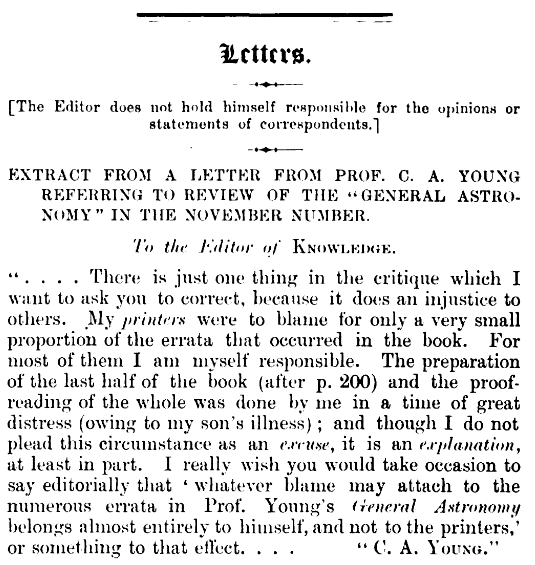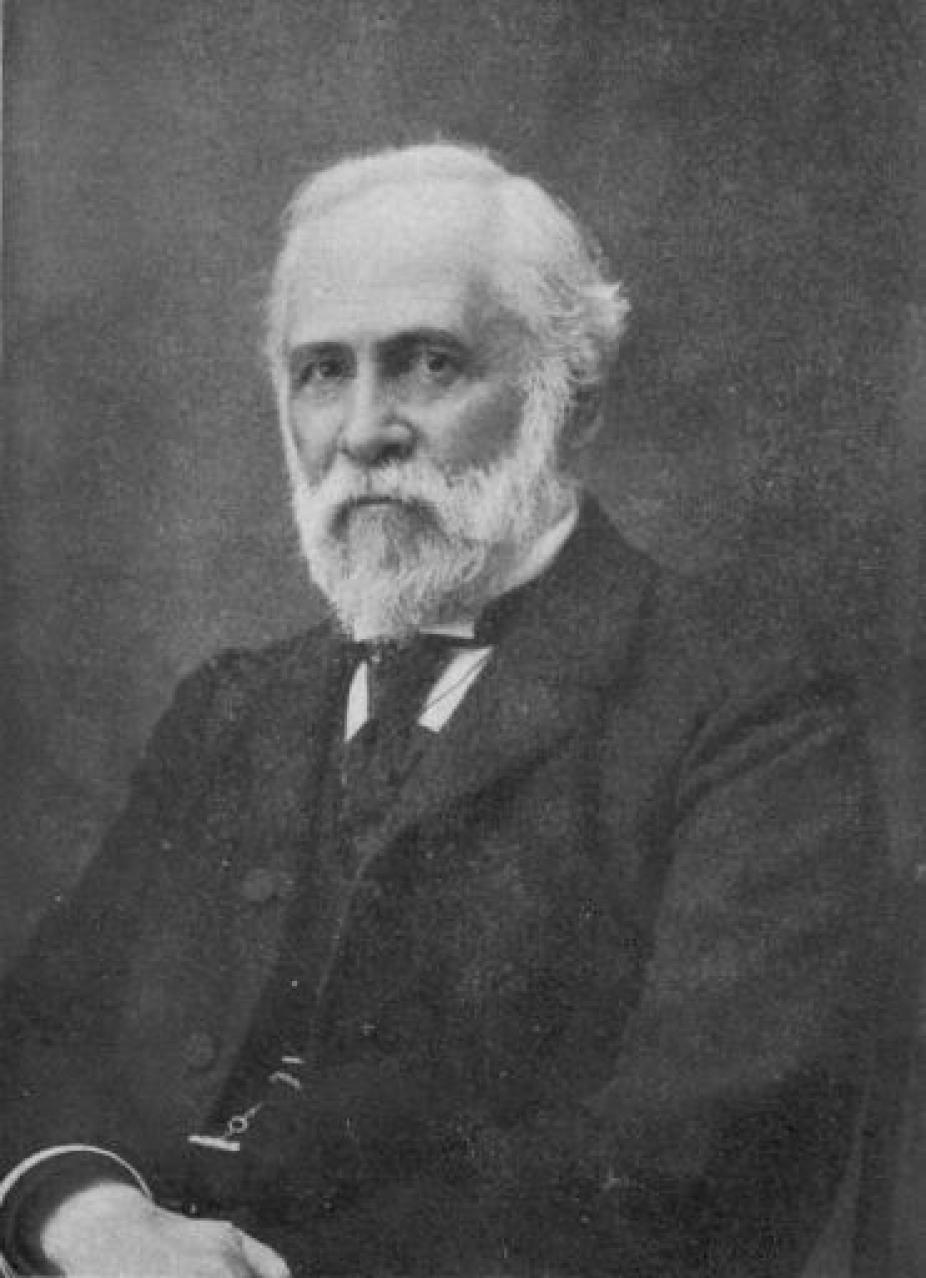A crucial element of a good apology is understanding the difference between explanation and excuse. Many of us mess this up. An explanation offers context that’s helpful to the person receiving the apology; an excuse offers context that’s designed to make the person who is putatively apologizing look less guilty.
A kind SorryWatch reader sent us this letter from 1890 (EIGHTEEN HUNDRED AND NINETY!), showing that even way back before there was social media, a prominent personage understood the difference between explanation and excuse. We don’t have the full text of the letter, so we’re not sure if the fellow used the words “I’m sorry” or “I apologize,” but the part of the letter we DO have is a perfect example of taking responsibility. Check it out.
In November 1890, the British journal Knowledge: A Monthly Record of Science ran a review of an astronomy textbook by Charles A. Young, professor of astronomy at the College of New Jersey (renamed Princeton University six years later). The review was largely favorable, though it took issue, as one does, with the section on meteoric debris. The unnamed reviewer also had concerns about Young’s discussion of the sun. Which was “treated…very meagrely”! JEEZ, Professor Young, what about the polarized light of the corona?? Or the connection between the corona and the development of sun spots?! AND, the review noted, there’s only one picture of a corona, “and that is wrongly oriented. It has its northern pole where its eastern equatorial region ought to be.” Gotcha!
The review noted, with some condescension toward the former colonies: “With all the advances that America has made, authors have more to contend with in the land of Franklin than they have here. The number of printer’s errors must have been very annoying to Professor Young.” PITY about the United States’s substandard printers.
Nevertheless, the review concluded, “Professor Young is an accomplished practical astronomer, and a teacher of great experience, as well as a popular exponent of science in lucid and simple language. He is also a man of wide reading, and the combination has given us an astronomical text-book of exceptional value.”
Professor Young responded to the review with a letter in the next issue of Knowledge:

To the Editor of Knowledge:
….There is just one thing in the critique which I want to ask you to correct, because it does an injustice to others. My printers were to blame for only a very small proportion of the errata that occurred in the book. For most of them I am myself responsible. The preparation of the last half of the book (after p. 200) and the proofreading of the whole was done by me in a time of great distress (owing to my son’s illness); and though I do not plead this circumstance as an excuse, it is an explanation, at least in part. I really wish you would take occasion to say editorially that “whatever blame may attach to the numerous errata in Prof. Young’s General Astronomy belongs almost entirely to himself, and not to the printers,” or something to that effect…. C. A. Young
A.C. Ranyard, Knowledge‘s editor, noted that Young’s son had been gravely injured by an electrical shock, which surely was a distraction for him at the time. Ranyard noted, “We are now so widely welcoming the Dangerous Demon of Electricity, that the accident to this promising young electrician (whom I remember as an Eclipse observer in Colorado in 1878) cannot be too widely used as a warning.” Indeed.
 Further, Ranyard observed that the November 1890 edition of Knowledge might not have been the place to snark at American printers. “Our last number was not a fortunate one in which to allude to the mistakes of American printers,” he wrote. “It contained a good many printers’ errors – probably due to the fact that it was the first number printed by fresh printers.” MMMKAY.
Further, Ranyard observed that the November 1890 edition of Knowledge might not have been the place to snark at American printers. “Our last number was not a fortunate one in which to allude to the mistakes of American printers,” he wrote. “It contained a good many printers’ errors – probably due to the fact that it was the first number printed by fresh printers.” MMMKAY.
Young’s attempt to make sure the printers weren’t held responsible for his mistakes reminds us of NASA launch manager Wayne Hale wanting to be sure that the factory workers who’d installed the foam insulation on the Space Shuttle Columbia weren’t blamed for the foam’s cracking. Taking responsibility for errors is a hallmark of good leadership.
And Professor Young sounds like a good egg in general: unpretentious, eager to popularize science, willing to admit when he was wrong—professionally as well as personally. A 1909 obituary in Astrophysical Journal noted, “To those who missed the opportunity of knowing him, it may be said that he was thoroughly infused with the true scientific spirit—ever ready to modify theory to accord with newly discovered facts, and to accept the revision of what were once the best facts available as new information was obtained by experiment and observation. He was entirely free from the dogmatism that often grows upon men with an enlarging reputation as authorities upon a subject. His modesty, even humility…was a true characteristic of his greatness.”
Young left academic life in 1862 to fight for the Union in the Civil War, an experience that had a longterm impact on his health. When he returned to teach at Dartmouth, he made time to lecture at women’s colleges as well (Dartmouth was, of course, all male), and despite his growing international scientific stature, he regularly contributed to Popular Science magazine. He even wrote occasional science articles for New York newspapers, which “did not at that time crave sensational articles so much as now,” the obituary in Astrophysical Journal helpfully noted. (The obit added that “probably the financial stress, so familiar in the experience of college teachers, was also a partial motive for some of these contributions.”) Even his most scholarly work was written accessibly, “in such a simple and interesting manner as to attract and hold the intelligent general reader.” He was a man of strong Christian faith (he’d even attended seminary school before choosing to focus on astronomy) but “there was not to him any serious antagonism between the fundamentals of science and of religion,” the obit said. “This position gave him considerable influence among those having to do with theological instruction; and, on the other hand, it had its useful effect upon his many college students, who had for him only the highest respect.” His students also liked the fact that his lectures “were enlivened by a quaint humor” and that he learned every student’s name, even in his large lecture classes, which brimmed with students “attracted probably more by the teacher than by the subject.”
In short, he sounds like the kind of guy who’d be generous to admit that he wrong when presented with new data. Who’d take responsibility for his mistakes. Who wouldn’t throw the people who printed his books under the bus.
Be like Charles.
Image Credits: NASA/Goddard Space Flight Center/SDO, Wikipedia

